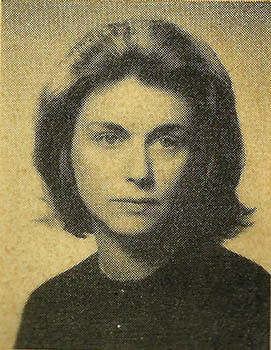Tag: conferences
A LAUC-B Conference to Remember!

LAUC-B is the Berkeley chapter of the Librarians Association of the University of California, and it helps us librarians in so many ways. When we come to campus to interview, we have lunch with LAUC-B representatives (and the conversation is confidential, so we can ask the REAL questions we have). When we arrive as new librarians, LAUC-B connects us with mentors. It provides support for our promotion and review process, and it provides a strong sense of community as we navigate this complicated campus.
One important thing LAUC-B does is offer professional development sessions, culminating in its conference every two years. The 2021 conference (which we posted about here the other day) just concluded, and multiple attendees, from all over the country (and even internationally) said that it was the best one they’ve attended in the past year (just to pat ourselves on the back a little bit!). So, what does a great librarian conference look like?
First of all, it takes a village; this year, for the first time, we Berkeley librarians welcomed librarians from other UC campuses to help us, and we had planning committee members from UCLA, UC Irvine, and UC San Diego. Second, it takes communication; in the online world created by the pandemic, at the same time we both needed to get the word out widely, and we were able to, by using email lists, social media, and other channels. This was so important, because the conference content—which was amazing—depended on us reaching a range of people and settings and locations. Third, it takes flexibility (with a large dose of preparation)! The planning committee was taking the conference from its historical in-person format to happening online for the first time, and that came with many challenges, even given the wonderful support from the Library Events Department—we changed conference platforms at the last minute, we became experts at Zoom bombing prevention, and learned more than we thought possible about captioning so that we could be ADA compliant.
The title of the conference is “Reimagining Libraries Through Critical Library Practices”, and our description notes that: “Library work is embedded in and inherently tied to socio-political circumstances. The programming in this conference examines librarianship through the lenses of social justice, diversity, equity, inclusion and anti-racist work, Black studies, Latinx studies, Indigenous studies, cultural and critical ethnic studies, intersectional feminism, critical disability studies, postcolonial and decolonial studies, and queer interventions in digital studies.”
We felt extremely fortunate that the proposals we received were so on point and so strong and deep, including: invited keynote presentations from Clara Chu and Lalitha Nataraj; 6 additional featured presentations; 5 lightning talks; and 11 posters (with which attendees had two different time slots to engage). Many of the presenters included a land acknowledgement and/or a positionality statement as they began their talks, engaging the attendees to consider their own locations and positions, and the UC Berkeley statement included this Rematriation Resource Guide from the Sogorea Te’ Land Trust. Attendees also agreed to uphold the conference’s Code of Conduct Statement.
If you’d like a sense of the 2-day event, please take a look at the conference website, and also at our Twitter hashtag. Session recordings will soon be available, linked on the website and hosted on the Library’s YouTube channel. Also notable were the elegant design offerings, including the logo you see above, which were created by UC Berkeley Library staffer and graphic designer Sarah Chieko Bonnickson, as well as the atmospheric and stress-reducing playlist, which was relayed between sessions and about which people raved, by UC Berkeley librarian Kristina Bush. If you have questions or comments, feel free to contact us at laucbconfinfo [at] lists.berkeley.edu, and please enjoy the Twitter screenshots below, while we enjoy our (distanced) celebratory beverages!
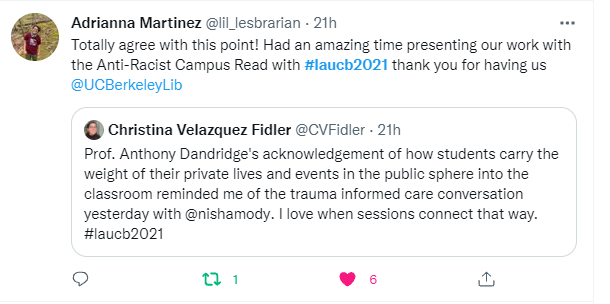
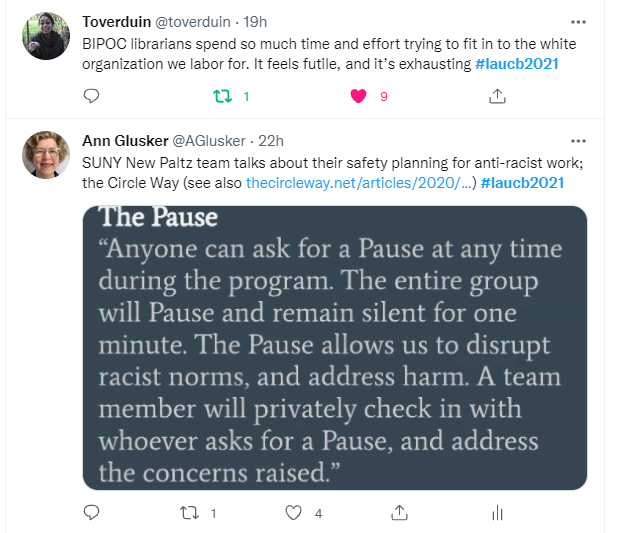
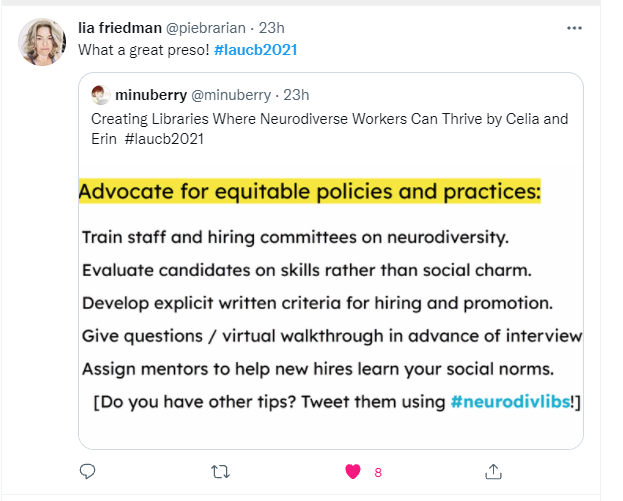
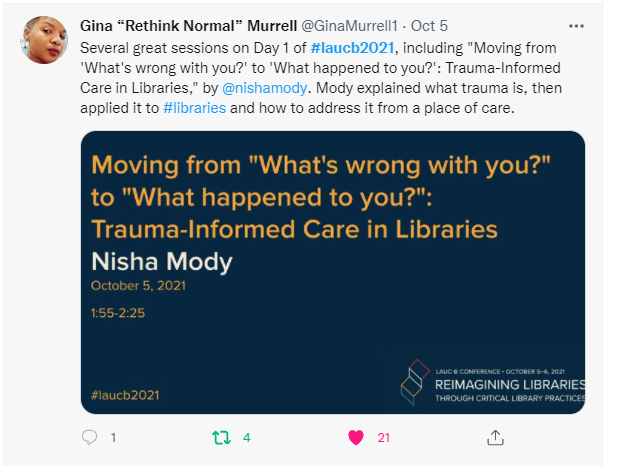
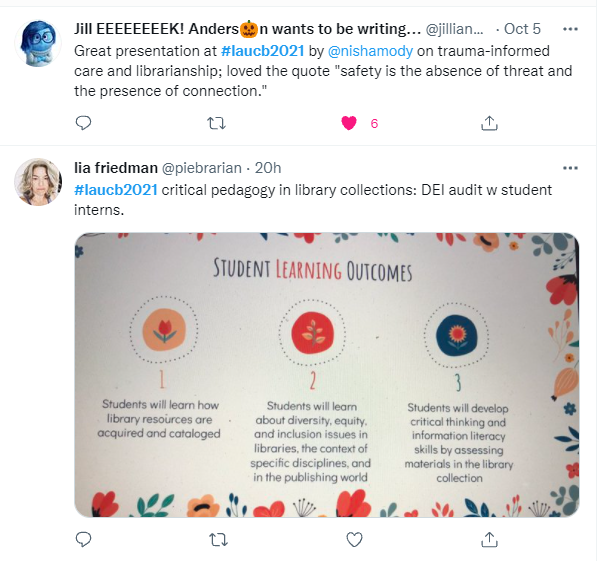
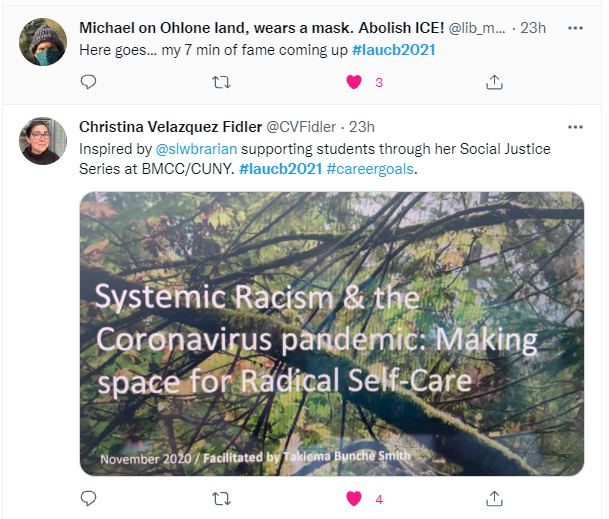
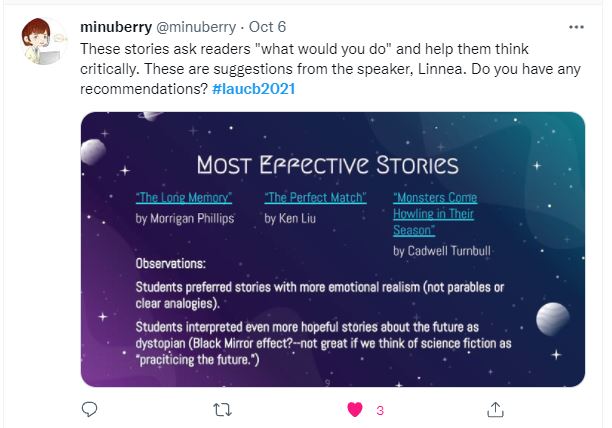
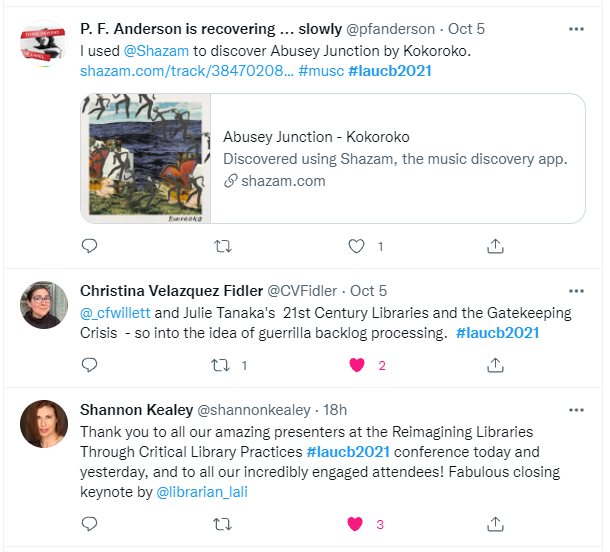
An Assembly of Janeites
I’m not sure what the collective noun is for Janeites* (the term popularized by Rudyard Kipling in his short story by that name) to denote admirers of the Georgian-era British novelist Jane Austen, but assembly will do as well as anything! The recent Annual General Meeting (AGM) of the Jane Austen Society of North America (JASNA), held in Williamsburg, VA was indeed an assembly of Janeites, and a fascinating one, attended by this UC Berkeley librarian (incidentally, a JASNA life member from long before the Colin Firth wet shirt scene).
JASNA has upwards of 6,000 members worldwide, and an impressive 850 attended this AGM (which filled up within five minutes of going live online), from every US state but 3 and every continent but Antarctica. The AGM is an agreeable panoply of lectures (some popular, but mostly academic, including three excellent plenary addresses), special events such as tours and concerts, and a ball and promenade. To say it’s a cross between a ComicCon-like event and a discipline-specific scholarly gathering doesn’t do it justice—there is some indefinable aspect added by the focus on the Georgian/Regency era and the passion for one ironic, wise, delectable, insightful, and compassionate author. And the period-appropriate garb doesn’t hurt, especially when its background is Colonial Williamsburg, a veritable time capsule itself.
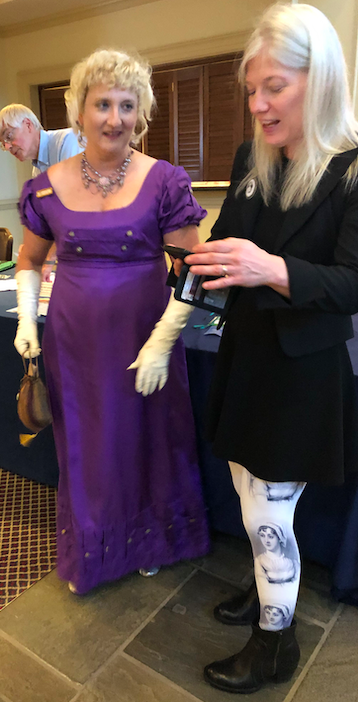
Herewith some highlights of this year’s AGM, for you readers who are interested in a glimpse of this delightful conclave:
—Let’s begin with some academic cred! Here are the lists of the conference’s breakout sessions and plenary addresses, complete with presenters’ bios. Nothing if not majestic scholarship on show!
—Continuing with the academic theme, my favorite part of the entire conference (what can I say? I’m a librarian!) was the tour and open house of Special Collections at the library of the College of William & Mary. William & Mary is second only to Harvard University as the oldest higher education institution in the US, was founded in 1693, and is the only one founded by royal charter, from, you guessed it, co-regnants William and Mary. For more detail on the tour, see this piece which appeared in William & Mary news. Overall, it was just amazing to see the depth of the holdings, and those related to Jane Austen in particular. Some of the most notable are thanks to an American Janeite, George Holbert Tucker, whose extensive and meticulously documented collection is now held at William & Mary. At the same time, there were many other period treasures on display, among them this donation of a lock of Queen Mary’s hair.
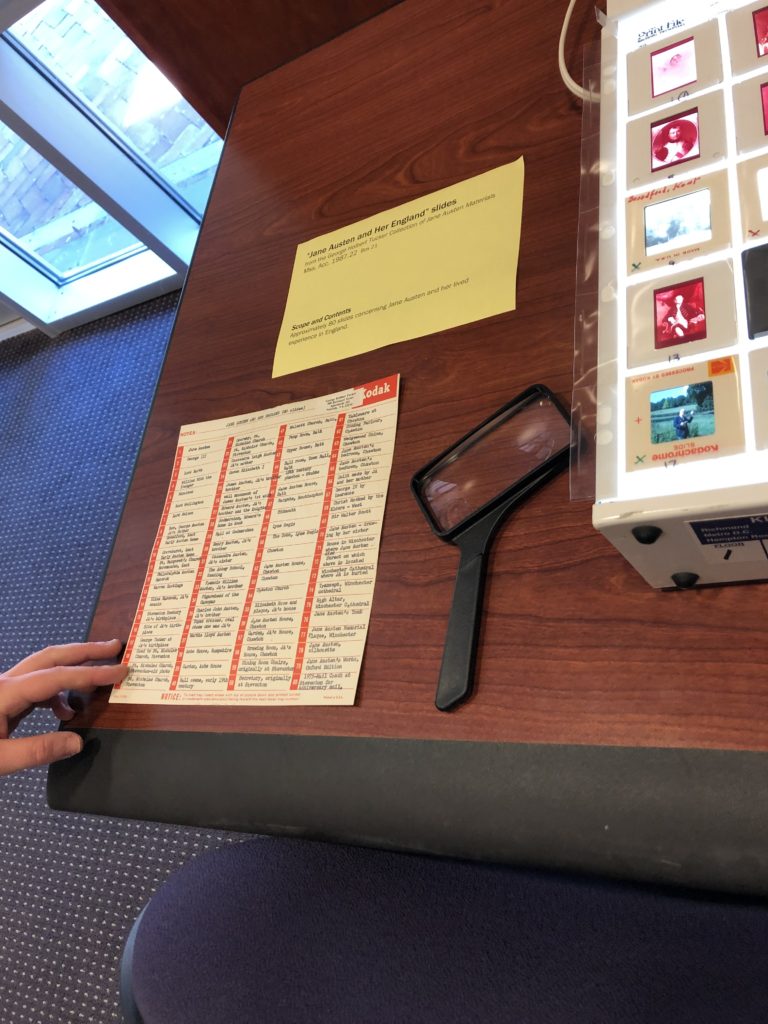
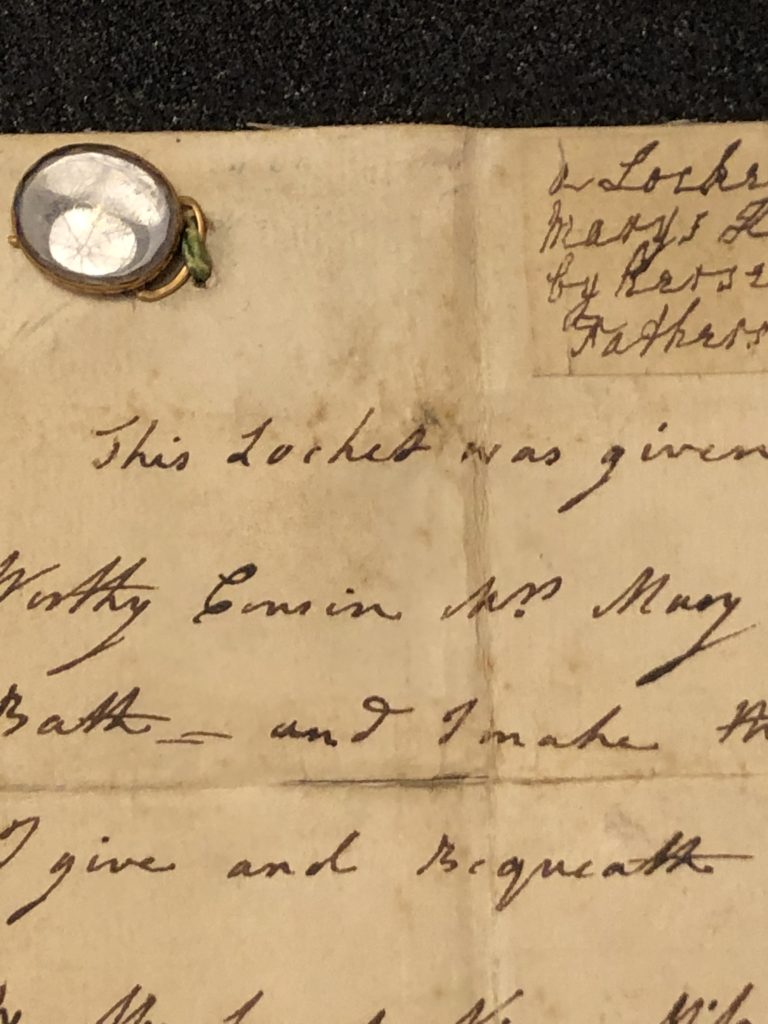
—Of course, there were also tours of Colonial Williamsburg. Of special interest was the home of George Wythe (the original structure still stands), with whom Thomas Jefferson lived and studied law for three years. John Marshall, fourth Chief Justice of the Supreme Court, also lived in Williamsburg and studied with Wythe; in addition, Marshall liked reading Jane Austen! He wrote of her: “Her flights are not lofty, she does not soar on an eagle’s wings, but she is pleasing, interesting, equable, yet amusing.”
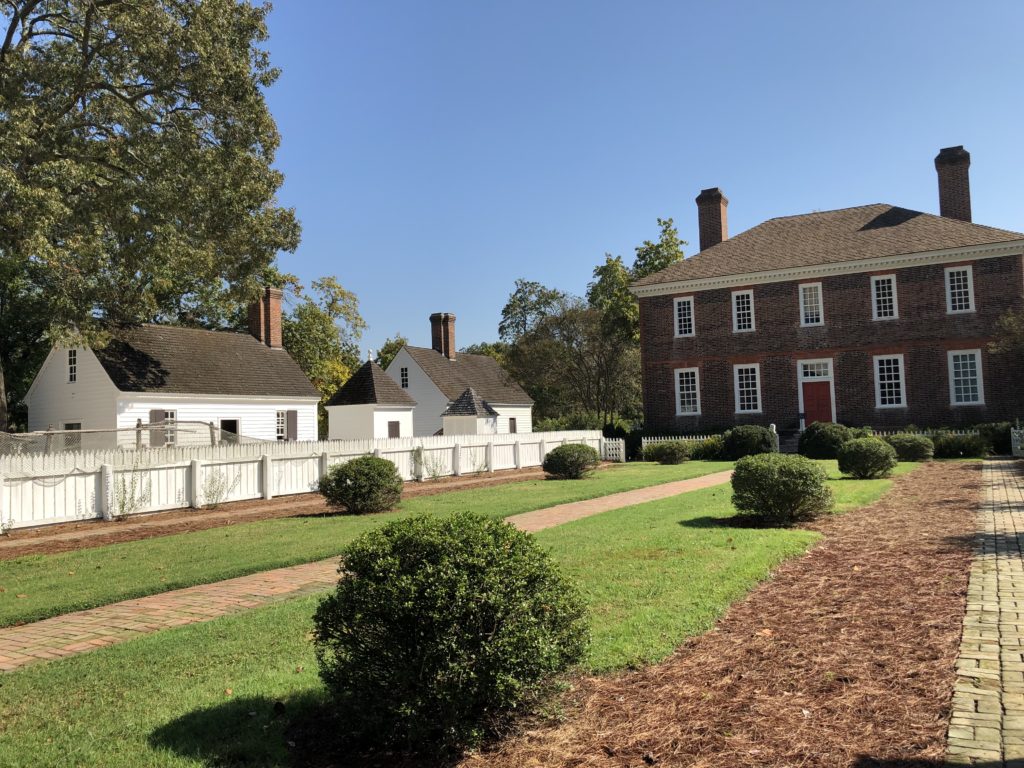
Also, being a librarian, I was very interested to see a demonstration of colonial-era typesetting and printing (unfortunately, the bookbinding demonstrations were not happening when I was there):
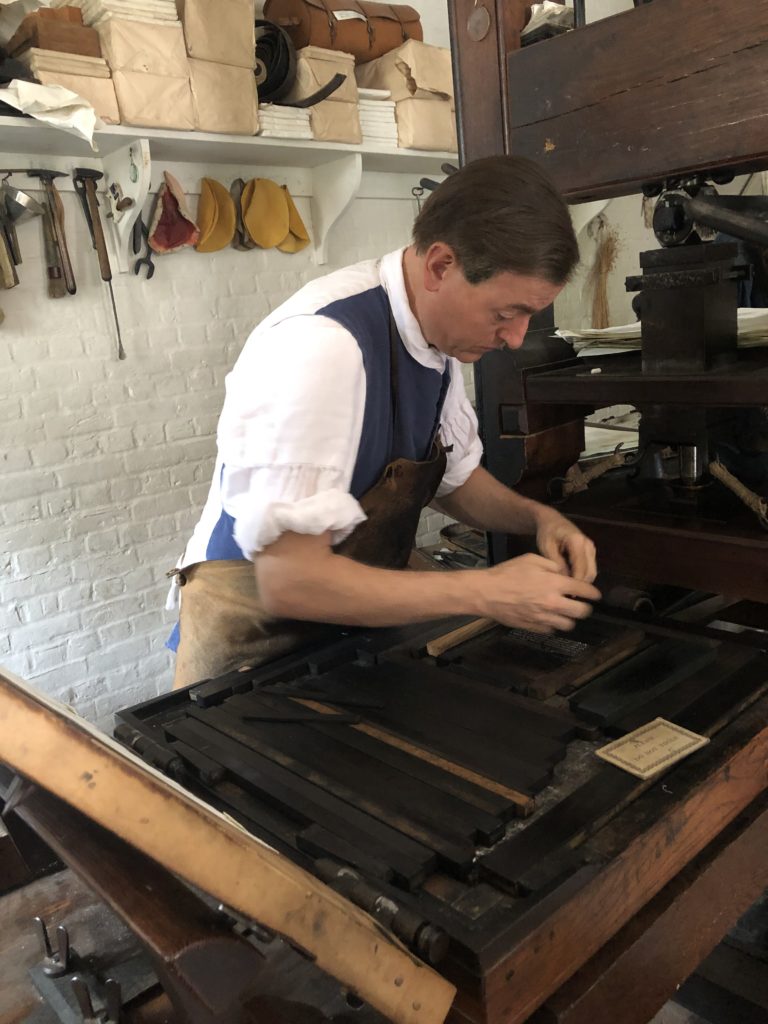
—The promenade and ball are the hallmarks of any AGM. After dinner, the entire assembly does a promenade, in their finery for the ball, around any location at which they happen to be meeting (when I attended an AGM in Washington DC, the promenade took place on the escalators connecting four levels of the hotel— quite a sight). This time, we strolled at dusk to the Governor’s Palace, led by four torch bearers (with modern protective gear—those torches were huge!) where an actress told us period-appropriate ghost stories. Then we gathered for the ball, to dance and drink and carouse. The music was provided by a small string ensemble, and a caller with the calmest voice imaginable led the lines of dancers in the sometimes-intricate moves. Luckily everyone was good-humored!

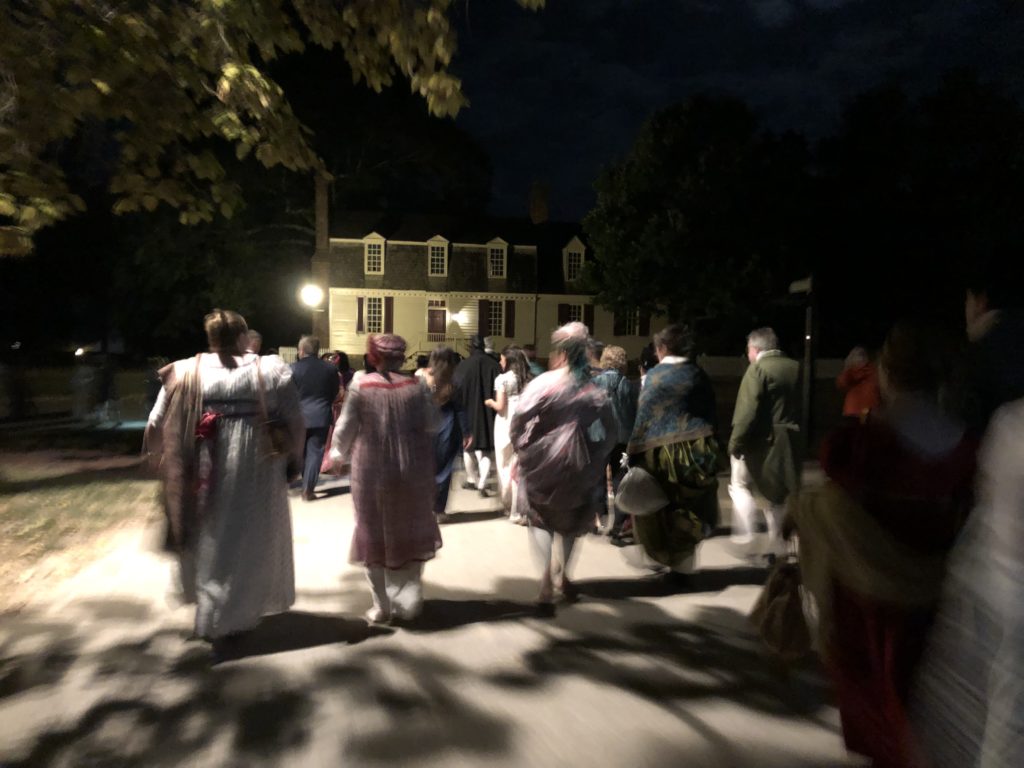
—The attention to dress is something that has always marked an assembly of Janeites (as it marked the interests of many of Jane Austen’s characters, at a time when distinctions in dress spoke more loudly than words). At the conference, this could be seen in both modern expressions (as in this T-shirt with its reference to Lady Catherine de Bourgh’s admonishment of Elizabeth Bennet in Austen’s Pride and Prejudice), and in scrupulous care with period detail in the many outfits worn by attendees, especially at the ball. In Colonial Williamsburg, where the park interpreters are dressed in colonial era period-appropriate apparel (mostly from the second half of the 18th century), conference attendees in Georgian/Regency attire (from the late 18th to early 19th centuries) didn’t stand out as much to our modern eyes. However, they would have stood out in the late 1700s, when wearing rich and patterned clothing identified one as a loyalist to the crown, and was positively unpatriotic (patriots wore homespun).
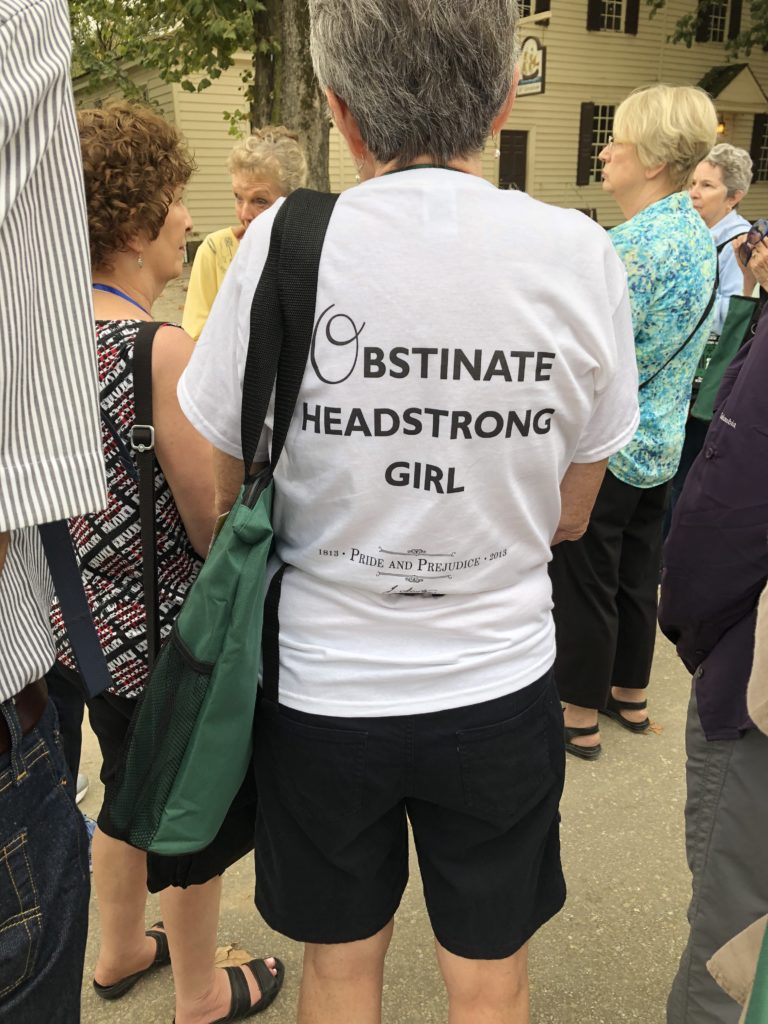
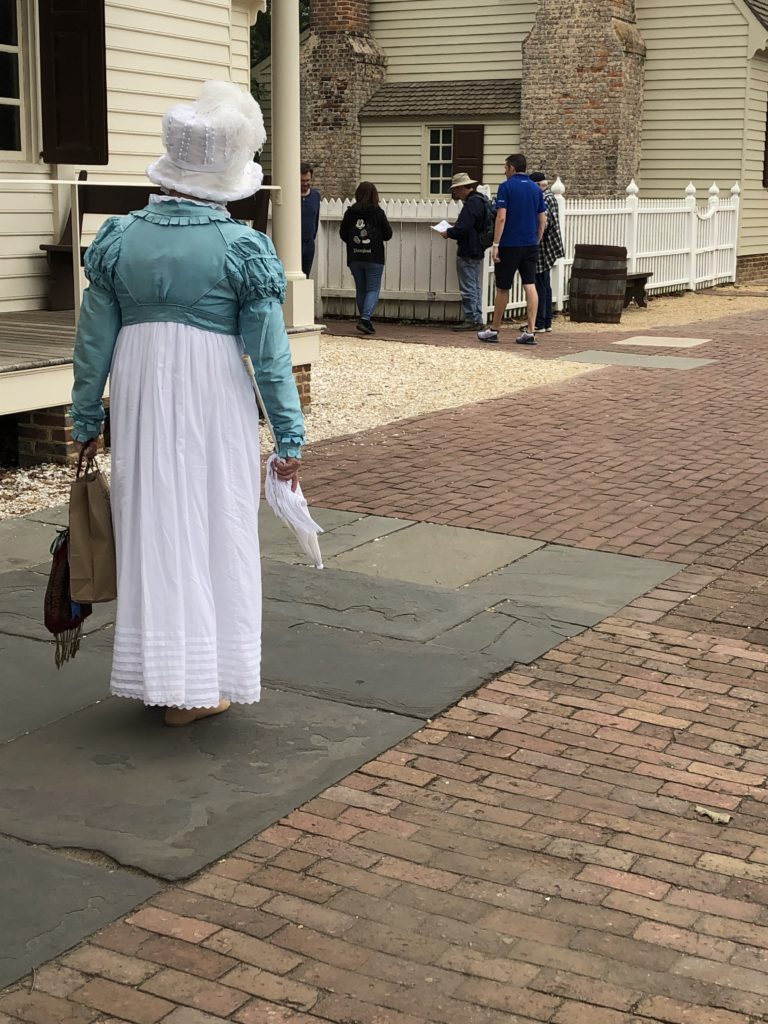
—On the final afternoon, there was an 18th century cricket demonstration. The rules were somewhat different then than in modern cricket! (the largely north American audience might not have been as aware of differences). And in case you are wondering that the photo shows a woman playing, Austen tells us that Catherine Morland, heroine of Northanger Abbey (the novel on which this year’s conference focused) loved cricket as a girl and played it with her brothers!
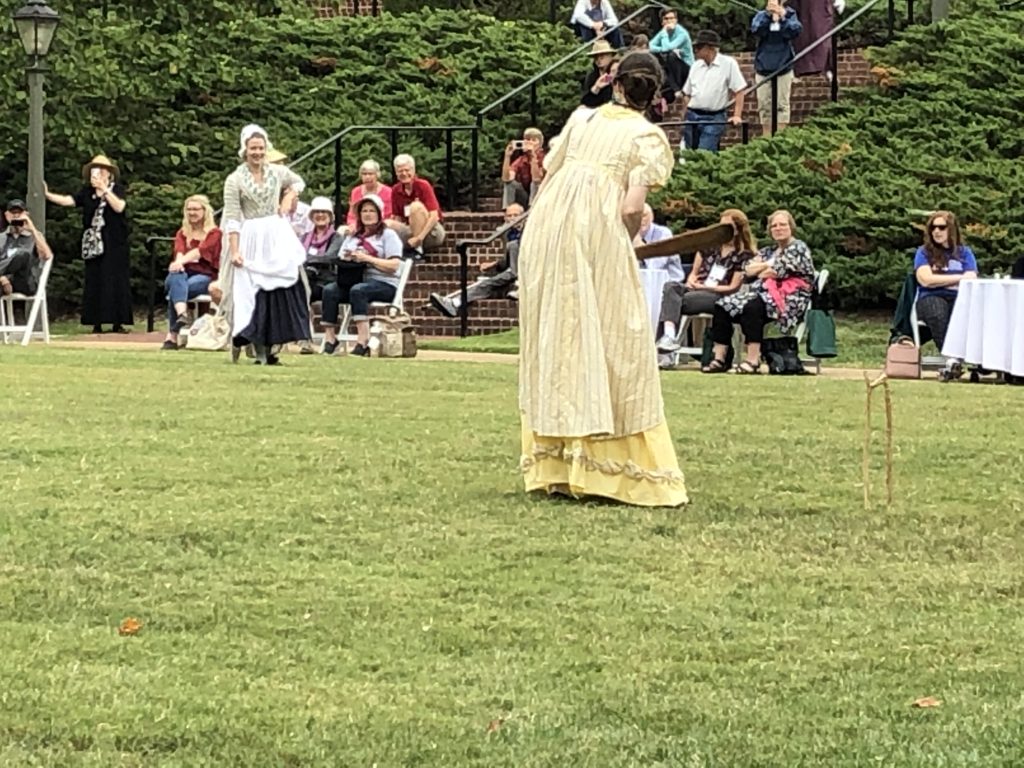
Intrigued? If you haven’t read any Jane Austen, or if you tried as a teenager and couldn’t warm to it, maybe have another look… Here is a complete set, free and online, from the wonderful Project Gutenberg. For introductions to her life and work, try Jane Austen (with an introduction by Harold Bloom), or The Cambridge Introduction to Jane Austen. And for more reading on Jane Austen devotees, try Among the Janeites or The Making of Jane Austen. For a video of a spirited debate comparing Jane Austen and Emily Brontë, check out this one from IntelligenceSquared. And consider joining us at the JASNA 2020 AGM next year in Cleveland!
*The term Janeite is often not used as a compliment; see this decidedly non-neutral Wikipedia overview. However, for the purposes of this article, the term is used affectionately!
Ana Hatherly Bibliography + Conference/Symposium + Talk
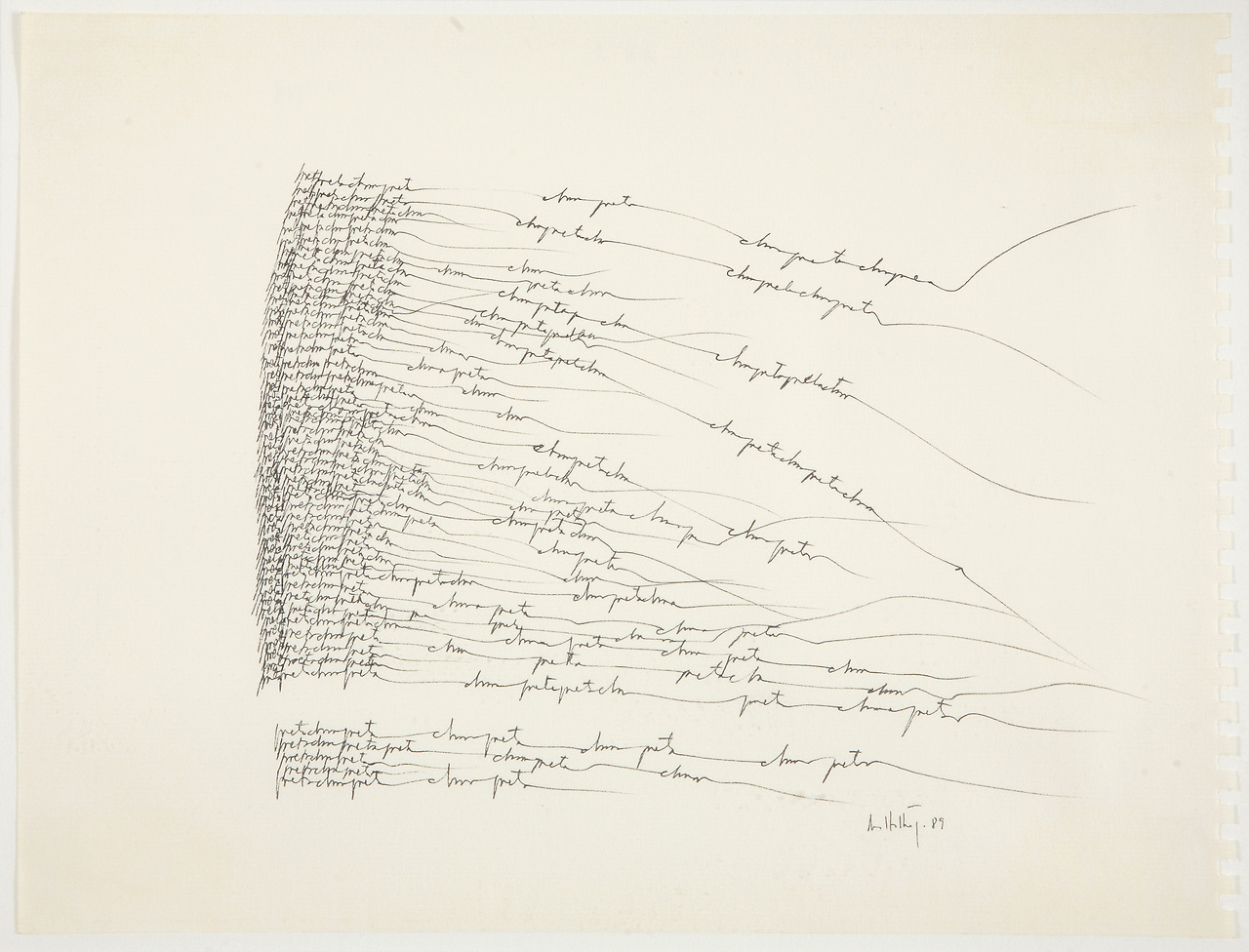
In anticipation of the conference/symposium on Portuguese visual artist/poet/scholar/filmmaker Ana Hatherly (1929-2015), we’ve assembled a bibliography of works authored by and about her in the Berkeley Library. Hatherly was one of the pioneers of the experimental poetry and literature movement in Portugal and already well-known in Europe before earning her PhD at Berkeley in 1986. Many of the books in the collection came to the Library through her dissertation advisor Arthur Askins who maintained close contact with her after she returned to Portugal. Other books were acquired more recently through the support of the Portuguese Studies Program in the Institute of European Studies (IES) and from donors such as retired Berkeley librarian AnneMarie Mitchell.
Between the lines: Tradition and Plasticity in Ana Hathery | Entrelinhas: tradição e plasticidade em Ana Hatherly, which will take place this Friday, March 22 in Stephens Hall, is the third conference/symposium since IES and the Camões Institute in Lisbon inaugurated the Catédra Ana Hatherly, or Chair, in Portuguese Studies in 2017. Tomorrow morning, Patrícia Lino who is currently a Camões lecturer at UC Santa Barbara will give a talk in English on the poetry of Ana Hatherly in Barrows Hall that is free and open to the public.
Great talks and fun at csv,conf,v3 and Carpentry Training
Day1 @CSVConference! This is the coolest conf I ever been to #csvconf pic.twitter.com/ao3poXMn81
— Yasmina Anwar (@yasmina_anwar) May 2, 2017
On May 2 – 5 2017, I (Yasmin AlNoamany) was thrilled to attend the csv,conf,v3 2017 conference and the Software/Data Carpentry instructor training in Portland, Oregon, USA. It was a unique experience to attend and speak with many people who are passionate about data and open science.
The csv,conf,v3
The csv,conf is for data makers from academia, industry, journalism, government, and open source. We had amazing four keynotes by Mike Rostock, the creator of the D3.js (JavaScript library for visualization data), Angela Bassa, the Director of Data Science at iRobot, Heather Joseph, the Executive Director of SPARC, and Laurie Allen, the lead Digital Scholarship Group at the University of Pennsylvania Libraries. The conference had four parallel sessions and a series of workshops about data. Check out the full schedule from here.
.@ErinSBecker is talking @CSVConference about @datacarpentry & @swcarpentry workshops! #csvconf pic.twitter.com/beKOixMNrt
— Yasmina Anwar (@yasmina_anwar) May 2, 2017
If you wanna change the culture, start early! @ProjectJupyter @openscience @CSVConference #csvconf pic.twitter.com/7OVMjMvVrc
— Yasmina Anwar (@yasmina_anwar) May 2, 2017
"Speak out, step up, take actions" Great ending for an amazing keynote by @hjoseph @CSVConference #csvconf pic.twitter.com/O4Vogsfhe4
— Yasmina Anwar (@yasmina_anwar) May 2, 2017
Fascinated by @yasmina_anwar's research on using web archives to automatically create histories for the next generation. #csvconf pic.twitter.com/sbI359n5Bk
— V Ikeshoji-Orlati (@vikeshojiorlati) May 3, 2017
I presented on the second day about generating stories from archived data, which entitled “Using Web Archives to Enrich the Live Web Experience Through Storytelling”. Check out the slides of my talk below.
I demonstrated the steps of the proposed framework, the Dark and Stormy Archives (DSA), in which, we identify, evaluate, and select candidate Web pages from archived collections that summarize the holdings of these collections, arrange them in chronological order, and then visualize these pages using tools that users already are familiar with, such as Storify. For more information about this work, check out this post.
https://twitter.com/HamdanAzhar/status/859851223515582464
The csv,conf deserved to won the conference of the year prize for bringing the CommaLlama. The Alpaca brought much joy and happiness to all conference attendees. It was fascinating to be in csv,conf 2017 to meet and hear from passionate people from everywhere about data.
#commaLlama is in the chapel 😃! This is amazing! #csvconf @CSVConference pic.twitter.com/cnQJzQ9L3h
— Yasmina Anwar (@yasmina_anwar) May 3, 2017
#commaLlama with @CLIRnews fellows @vikeshojiorlati and @yasmina_anwar @CSVConference #csvconf pic.twitter.com/Mpfooy9ccP
— Yasmina Anwar (@yasmina_anwar) May 3, 2017
#Trump 😒 😡vs #Clinton😭💕 #emoji #emojis #electionsemojis #csvconf pic.twitter.com/yYoUzm158H
— Yasmina Anwar (@yasmina_anwar) May 3, 2017
#Data needs to be findable, accessible, interoperable, reusable! @rchampieux #csvconf pic.twitter.com/1VIQzHSIh4
— Yasmina Anwar (@yasmina_anwar) May 3, 2017
Shout out for all @CSVConference organizers! We enjoyed all the talks, keynotes, #commaLlama #csvconf #data pic.twitter.com/BLjRCCRYdu
— Yasmina Anwar (@yasmina_anwar) May 4, 2017
After the conference, Max Odgen from the Dat Data Project gave us a great tour from the conference venue to South Portland. We had a great food from street food trucks at Portland, then we had a great time with adorable neighborhood cats!
https://twitter.com/yasmina_anwar/status/860017390968492032
Tha Carpentry Training
Congratulations, everyone! You did it! Portland 2017 cohort of @datacarpentry / @swcarpentry Instructors! @LibCarpentry #porttt pic.twitter.com/J3ceEzwOBQ
— Library Carpentry (@LibCarpentry) May 5, 2017
https://twitter.com/LibCarpentry/status/860571982479241216
The two days had a mix of lectures and hands-on exercises about learning philosophy and Carpentry teaching practices. It was a unique and fascinating experience to have. We had two energetic instructors, Tim Dennis and Belinda Weaver, who generated welcoming and collaborate environment for us. Check out the full schedule and lessons from here.
.@yasmina_anwar just convinced me to fall in love with RStudio from her live code teaching example at #porttt.
— Elaine Wong (@elthenerd) May 5, 2017
At the end, I would like to acknowledge the support I had from the California Digital Library and the committee of the csv,conf for giving me this amazing opportunity to attend and speak at the csv,conf and the Carpentry instructor training. I am looking forward to applying what I learned in upcoming Carpentry workshops at UC Berkeley.
–Yasmin
Orpheu and the Avant-Garde Poetry conference
An all-day conference commemorating the Portuguese literary journal Revista Orpheu will take place this Friday, October 16 at UC Berkeley’s Institute of European Studies. An exhibition will follow.
Boccaccio conference starts today

A Boccaccian Renaissance – an interdisciplinary and international conference – will explore the figure and works of Giovanni Boccaccio from the point of view of their extraordinary, yet little remarked impact on early modernity. It will have a dual focus on Boccaccio’s own understanding of his cultural program and on the direct and indirect impact of his works on the vernacular and Latin culture of the fifteenth and sixteenth centuries in Italy and throughout Europe (esp. England, Spain, and France).
A joint University of California, Berkeley and Stanford University Conference, October 24-26, 2013. With a generous contribution from the Italian Cultural Institute of San Francisco. For details, see: http://www.boccaccianrenaissance.com.
